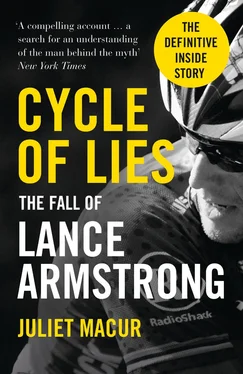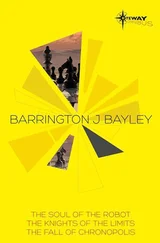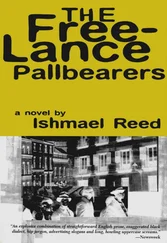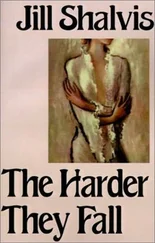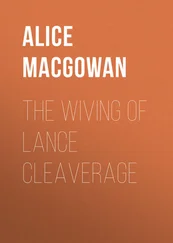Lance Armstrong was fourteen when he learned about Terry’s secret life. They were traveling to a swim meet in San Antonio. He saw Terry writing, then tossing away pieces of crumpled paper. The boy picked up a sheet of the paper and saw the beginnings of his father’s love letter to a mistress. To spare her the pain, he didn’t tell his mother. But Terry became an enemy to be crushed—another lost father.
Right away, Armstrong found a replacement: Rick Crawford, a professional triathlete. Crawford didn’t know what was in store when he met the fourteen-year-old Armstrong at a Dallas pool. They were swimming laps in adjacent lanes. Armstrong went all out to beat him. Crawford was impressed.
He’s not sure how it happened exactly, but Crawford—twelve years older, never a coach—helped Armstrong launch his triathlon career. Armstrong promptly became a star in the niche sport, someone race directors wanted at their event. They marketed him as a prodigy, a boy threatening to challenge the sport’s best athletes. Crawford was astonished at how quickly Armstrong excelled. His national triathlon ranking improved by the day, Crawford says, the number dropping “like shit through a goose.” They trained together for eighteen months.
Crawford says he was taken aback by Armstrong’s combativeness. He heard him at races tell competitors, “I’m going to kill you. You are pathetic.” He would say those things at the starting line and the finish. Crawford remembers telling him, “Lance, no. Not cool. Buddy, let your legs do the talking.”
On training rides, Crawford had to keep an eye on Armstrong, who saw every motorist as a threat. In a kind of bike rage, he would chase down cars that had come too close to him in order to curse and threaten the driver. He wouldn’t temper his emotions for anybody. Crawford noticed that was especially true when it came to the way Armstrong treated his father.
At first, nothing stood out to Crawford as unusual at the Armstrong residence in the Los Rios neighborhood, a solidly middle-class section of Plano. The Armstrongs lived in a simple brick ranch-style house: three bedrooms, 1,500 square feet, a patch of lawn, a couple green shrubs.
Then Crawford began to hear Armstrong’s stories of his family’s problems. He heard about Armstrong and his father taking swings at each other and landing on a glass coffee table, smashing it. “He was encouraged to be bad,” Crawford says. Family friends saw a teenager out of control.
While Linda and Terry Armstrong argued at home, Crawford spent more time with their son, training and traveling to events where they both were treated to free airfare and fancy hotel rooms because of their athletic abilities. That, too, was a learning experience. The night before a triathlon in Bermuda, Armstrong “borrowed” a scooter that Crawford had rented and returned it to the rental company hours late. Later, in a bungalow that housed several other professional triathletes, Armstrong broke glasses and bottles when he took a cricket bat and smacked a ball into the place’s wet bar.
Crawford had had enough. He was tired of doing the job of this kid’s parents who, in his view, were lousy. He pinned Armstrong against a wall and growled, “You’re done, dude.”
“Screw off,” Armstrong said, “you’re not my dad! Don’t ever talk to me again.”
As he had with his biological father and Terry Armstrong, he left Crawford behind.
“I guess you couldn’t blame him,” Crawford says. “He was already staying in five-star hotels and having people adore him.”
Crawford remembers Armstrong’s behavior as Oedipal. He says most of the father figures in Lance’s life have ended up as villains and that every girl he has ever dated looks exactly like his mother.
In turn, Armstrong calls Crawford a bitter, “crazy and angry” guy. He also points out that Crawford went on to help athletes dope. In 2012, years after he split from Armstrong, Crawford admitted to helping pro cyclists Levi Leipheimer and Kirk O’Bee of the United States Postal Service squad use performance-enhancing drugs. Crawford said he did it only because Armstrong had set the team’s standard of doping. He said those riders were neophytes who heard that Armstrong and other elite riders on the team were taking part in a sophisticated drug program. They only wanted to keep up. Still, Crawford later was fired from his coaching job at Colorado Mesa University for allegedly doping an athlete there, a charge he denies. As for the matter of Armstrong’s doping—might Crawford have ever helped a young triathlete bend the rules?
“No,” he said. “I would never put drugs into a young kid.”
Linda Armstrong always looked for people who could help Lance—and along came Scott Eder, a local sports promoter working for the sneaker company Avia. He crossed paths with Armstrong in 1986 at a biathlon in Dallas. After Armstrong won the event, Eder delivered a free pair of Avias to his house, and—one imagines—walked away with exactly what he was after.
Linda asked Eder, “Can you watch over my son, kind of act like his agent?”
Eder became, as Lance said later, “a coach meets agent meets big brother.”
Armstrong had already proven himself to be an amazing athlete. He was only thirteen when he won his first triathlon, an IronKids event, and was second in that year’s IronKids national championship. At fourteen, he was sneaking into races for adults, with Terry Armstrong changing the date on his birth certificate to make him eligible. The next year, he competed for the second time in the President’s Triathlon in Dallas, an event featuring many of the sport’s stars, like Mark Allen, an eventual six-time Ironman world champion.
A fifteen-year-old Armstrong wasn’t far behind the top competitors. He beat Allen in the swim. In the bike portion of that 1987 race, he pedaled alongside Allen and got his attention. “Are you Mark Allen?” Armstrong said. When Allen said yes, Armstrong remained by his side for nearly the rest of the event. Armstrong finished sixth, but made a name for himself as the next big thing in the sport.
Allen later told the President’s Triathlon race director, Jim Woodman, that the young Armstrong’s abilities were uncanny. “He couldn’t shake him, and that freaked him out,” Woodman said. The next year, Armstrong won the triathlon. He also won the Texas state championship, beating his own former mentor, Crawford, for the title. Triathlete magazine claimed that he would be one of the greatest athletes in the history of the sport.
By the time he was sixteen, he was making $20,000 a year and had turned pro. Eder was acting as his traveling secretary, event negotiator, marketing director and road manager. He compiled triathlon schedules, secured sponsors and budgeted for their races. Eder also arranged for Armstrong to spend two summers training in California with top triathletes.
In all, Eder told me, he traveled with Armstrong to more than twenty-five out-of-town races. He showed me the itineraries he had typed up on his typewriter. The travel—which included stays in expensive hotels like Bermuda’s Princess—was often paid for by the event sponsors. Armstrong was only a kid, and he already was being treated like a superstar. The Armstrongs didn’t need to spend a penny.
Linda has claimed to have been by her son’s side at most of those competitions. Eder differs. “She went to about three,” he says.
He saw the kid as a brawler with a touch of paranoia. If you glanced at him the wrong way, he might say, “What the hell are you looking at?” He’d sneak into a bar, get into a fight, and this underage boy would go back home with a bloodied nose and raw knuckles.
He once threw a Kestrel racing bike—one of the first generations of all-carbon-fiber racing bikes—across several lanes of road after his tire went flat during a Miami triathlon. Kestrel dropped its sponsorship of him. The tantrum had hurt Armstrong’s marketing appeal, especially since it was captured by television cameras.
Читать дальше
